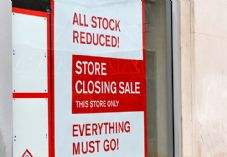UK DIY News
Barclays: Consumer Card Spending Slowed In January

- Supermarkets saw higher growth than in December, as consumers returned to their regular routines post-Christmas
- Demand for digital content and takeaways remained strong as consumers saved money by staying in and watching new releases such as ‘The Traitors’ and ‘Fool Me Once’
- The cold weather – including storms Isha and Jocelyn – meant many shoppers avoided the high-street, choosing to browse the January sales online instead
- Consumers’ confidence in both household finances and ability to live within their means reached its highest point since November 2021
- The Barclays Consumer Spend report combines hundreds of millions of customer transactions with consumer research to provide an in-depth view of UK spending
Consumer card spending grew 3.1 per cent year-on-year in January – less than the latest CPIH* inflation rate of 4.2 per cent, yet higher than December’s growth of 2.3 per cent. Retail, hospitality and leisure spending slowed as Brits stayed at home to shelter from the cold weather and save money after a busy festive period. However, pointing to improving optimism, consumers’ confidence in both their household finances and ability to spend within their means reached its highest point in over two years.
Spending on essential items increased 4.2 per cent – noticeably higher than in December (1.8 per cent). This was largely driven by a recovery in fuel spending, in light of the new energy price cap coming into effect 1 January, which saw a smaller decline (-9.7 per cent) compared to December (-12.5 per cent). Growth in supermarket spending increased to 5.2 per cent – up from 2.8 per cent in December – on par with the growth seen in October (5.2 per cent) and November last year (5.0 per cent), as UK consumers returned to their regular routines after the Christmas break.
Supermarket deal-seeking continues in 2024
As concerns around rising food prices remains high (87 per cent), two thirds (67 per cent) are continuing to look for ways to reduce the cost of, or get more value from, their weekly shop.
Of these consumers, half (47 per cent) are using loyalty schemes or vouchers to get money off shopping. Two in five (39 per cent) are shopping at multiple supermarkets to source a range of deals, while a similar proportion are buying discounted products nearing expiration, or “yellow sticker” items (38 per cent). In addition, almost a fifth are cutting back on buying meat, fish or other animal products as well as alcohol (both 18 per cent), while 16 per cent have even been buying discounted festive food to save money.
‘Staying in for the win’ this Valentines Day
Supermarket savings are also expected to impact Valentine’s Day celebrations, especially when it comes to gifts and food. Valentine’s Day is typically one of the busiest dates in the calendar for florists, second only to Mother’s Day – last year, transactions at florists on 13th February were up 450 per cent compared to the daily average for the year*. However half of those intending to buy flowers this year say they will save money by buying them from the supermarket instead of a florist. Similarly, a supermarket meal-deal is on the menu for just over two in five of those making a home-cooked meal.
Other cost-saving strategies include spending the evening at home instead of going out (21 per cent), setting a spending limit for gifts (18 per cent), and forgoing presents altogether (16 per cent).
Even with these cutbacks, Brits expect to spend slightly more this Valentine’s Day compared to last year (up £6.40), likely due to rising prices. In total, the average love-bird expects to spend £80.30 – with men expecting to spend over 50 per cent more than women (£96.70 compared to £60.70 for women).
Home comforts over big nights out
Spending on non-essential items increased 2.6 per cent in January – consistent with the growth seen in December and November last year, at 2.5 per cent and 2.7 per cent respectively. This comes as over two fifths (43 per cent) of consumers say they are planning to cut down on discretionary spending due to rising household bills, with many tightening their belts after the festive season.
Spending on takeaways and fast food was up 5.5 per cent year-on-year in January, with those that spent money on food to-go forking out £55 on average each. Meanwhile, digital content and subscriptions had yet another bumper month, up 11.4 per cent, following December’s 11.6 per cent boost, as Brits embraced nights in, enjoying new releases such as ‘Mean Girls’, ‘The Traitors’ and ‘Fool Me Once’.
This shift in behaviour, as well as the popularity of Dry January, meant that bars, pubs and clubs saw a smaller uplift (6.5 per cent) than in December (7.9 per cent), while restaurants faced a steeper month-on-month decline (-11.6 vs -8.8 per cent). Of those planning to limit discretionary spending throughout the winter, three in five (59 per cent) said they will be cutting back on eating out at restaurants.
Colder weather chills high-street spending
More shoppers opted to browse the post-Christmas sales from the comfort of their homes instead of the high-street in January. On Boxing Day itself, face-to-face retail spending was down 10.9 per cent year-on-year, likely due to the cold weather and the arrival of Storm Isha and Storm Jocelyn, as well as several major retailers opting to keep their doors shut. Encouragingly, this was offset by a 10.7 per cent jump in online retail spending.
Looking at January as a whole, 57.6 per cent of all retail shopping (excluding groceries) was online – the highest share of online spending in this category since February 2022. Meanwhile, clothing stores saw a -0.6 per cent decline, though this was a slight improvement compared to December (-2.0 per cent).
Optimism prevails
While rising household bills remain a concern for the majority (88 per cent), the nation is feeling more optimistic overall, with consumers’ confidence in both their household finances and ability to live within their means reaching its highest point since November 2021 (70 per cent and 74 per cent respectively).
Karen Johnson, Head of Retail at Barclays, said: "After a December filled with festive indulgence, Brits took on a more frugal approach in January, choosing to stay at home more often to save money and shelter from the winter weather.
“This meant that online retail performed strongly, as shoppers browsed the sales from the comfort of their sofas, while demand for digital content and takeaways remained robust, boosted by the release of popular new film and TV releases such as ‘The Traitors’ and ‘Fool Me Once’.
“While this shift in behaviour resulted in subdued growth for hospitality and leisure, it’s encouraging that confidence is improving, with consumers remaining resilient and finding savvy ways to manage their finances.”
Jack Meaning, Chief UK Economist at Barclays, said: “Increasing consumer confidence is a positive message for the UK outlook in 2024, as we see inflation continue to fall, real incomes rising and growing signs that interest rate cuts are coming. Spending looks to be on an upward trajectory, set to increase more than inflation in the coming months, which will be an important milestone for consumers and businesses who were squeezed throughout 2023.”
Overall growth figures
Spend Growth | Transaction Growth | |
Essential | 4.2% | 4.4% |
Non Essential | 2.6% | 4.5% |
|
| |
OVERALL | 3.1% | 4.5% |
Retail | 1.7% | 3.9% |
Clothing | -0.6% | 4.4% |
Grocery | 5.2% | 4.9% |
| 5.2% | 3.9% |
| 5.2% | 10.8% |
Household | -6.2% | 1.2% |
| -7.7% | -3.3% |
| -5.0% | 4.4% |
| -6.1% | 0.2% |
| -1.2% | 4.3% |
General Retailers | 3.1% | 3.8% |
| 5.6% | 7.1% |
| 0.1% | 6.9% |
| -8.6% | -12.0% |
Specialist Retailers | 1.0% | 0.4% |
| 6.9% | 2.7% |
| -4.2% | -5.5% |
| -0.9% | -0.6% |
Hospitality & Leisure | 6.6% | 6.0% |
Digital Content & Subscription | 11.4% | 7.0% |
Eating & Drinking | 5.3% | 3.3% |
| -11.6% | -14.0% |
| 6.5% | 5.3% |
| 5.5% | 2.4% |
| 9.1% | 5.2% |
Entertainment | 5.3% | 7.4% |
Hotels, Resorts & Accommodation | 0.6% | 3.0% |
Travel | 8.9% | 12.7% |
| 8.0% | 10.8% |
| 9.3% | 17.7% |
| 10.8% | 10.6% |
| 8.6% | 16.4% |
Other | 2.2% | 2.7% |
Fuel | -9.7% | -3.2% |
Motoring | 1.2% | 2.9% |
Other Services | 9.6% | 11.7% |
Insperiences | 6.8% | 4.4% |
|
|
|
Online | 4.0% | 7.1% |
Face-to-Face | 2.3% | 3.3% |
Source : Barclays
Image : shutterstock.com / 116422102
Thank you for the excellent presentation that you gave at Woodbury Park on Thursday morning. It was very interesting and thought-provoking for our Retail members. The feedback has been excellent.











































